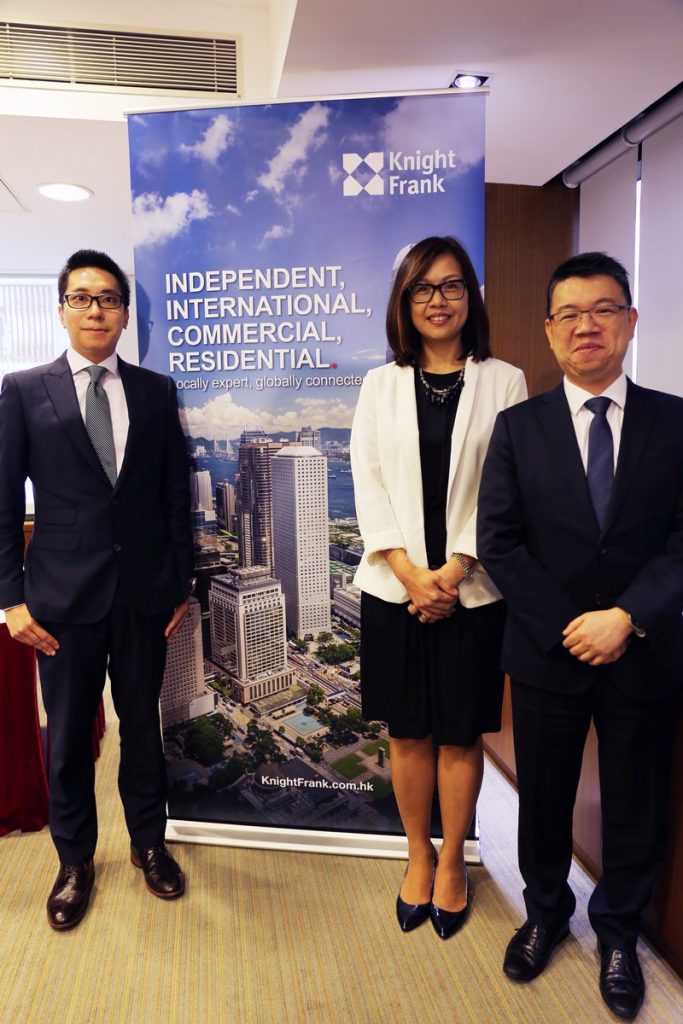(1 June 2017, Hong Kong) In Hong Kong, despite the implementation of further stamp duty policies and a new round of measures regarding property mortgage loans, mass residential home prices are expected to increase by 5-10% this year. Total home sales volume for 2017 is expected to reach around 60,000-65,000 in 2017. In Mainland China, with various property market cooling measures in place, residential prices continued to rise. Mild home prices increases are expected in both first-tier and major second-tier cities over 2017.
(中文简体版请按此)
At a press conference held in Knight Frank’s Hong Kong office this afternoon, Thomas Lam, Senior Director and Head of Valuation & Consultancy, together with David Ji, Director and Head of Research & Consultancy, Greater China, reviewed the Hong Kong and Mainland property markets in the first half of 2016 and presented their forecasts for the second half.

From left to right (Thomas Lam, Senior Director and Head of Residential Agency Maggie Lee and David Ji)
Mainland China residential market
- The Mainland’s GDP is expected to stablise at above 6% in the next few years. The Central Government will need to find a way to absorb increased wealth brought along by the economic growth, and income which generates investment demand, much of it is expected to go into real estate in a low-interest rate environment.
- Despite various property market cooling measures, including home purchase restrictions (HPR) and increased down-payment ratio, Mainland’s residential prices continued to rise. In March 2017, 62 out of the 70 major Mainland cities tracked recorded month-on-month home price increases.
- Home prices in lower-tier cities, in particular, recorded a strong growth, with Hefei (34.7%) seeing the fastest year-on-year increase in March 2017, followed by Xiamen (32.3%) and Wuxi (31.8%). Of the 10 Mainland cities with the fastest price growth, Guangzhou was the only first-tier city. This is attributable to a stricter implementation of cooling measures in first-tier cities in order to suppress runaway price surge. In contrast, there are relatively less stringent controls in lower-tier cities as their key objective is still to clear the huge housing inventory.
- Since August 2016, the Central Government has widened HPR. The number of Mainland cities that have implemented with HPR has increased to 45 as of April 2017. These cooling measures are expected to impact the transaction volume. However, price growth, especially that in the first-tier cities, will still see some growth albeit at a much slower pace.
- HPR is expected to remain in these 45 cities in 2017, with more cities expected to join should their housing markets overheat. Although residential inventory across the Mainland decreased 11% year on year in 2016, thanks to a 22.3% year-on-year growth in residential sales last year, destocking property inventory will remain a major task in 2017, especially for lower-tier and inland cities.
- Over 2017, David Ji expects mild rises in Mainland home prices, with first-tier and major second-tier cities seeing price growth of 3-5% and 2-4% respectively.
Hong Kong residential market
- Despite ongoing implementation and further tightening of property market cooling measures, including a 15% stamp duty levy on first-time homebuyers purchasing multiple flats in one go in April and a new round of measures on property mortgage in May, Hong Kong’s home prices continued the upward trend. According to official data, home prices continued to grow in the 12 months ending March 2017. They gained an accumulated 18%, surpassing the previous peak in 2015.
- Residential affordability remains a major concern for potential homebuyers. In March 2017, affordability ratio increased further to 65%, compared with 62% a year ago. The actual contractual life for new residential mortgages increased to 27 years, compared with 25 years one year ago.
- Demand from both investment and end-user remains strong despite the cooling measures. Developers continue offering various beneficiary packages to lure buyers and the primary sector remains dominating. Total residential sales reached 20,281 during the first 4 months of 2017. They are expected to reach about 60,000-65,000 in 2017, up from 54,701 in 2016.
- Mainland developers have been increasingly active in residential land site acquisition in Hong Kong. So far in 2017, all residential land sold by the Hong Kong government went to the pockets of Mainland developers with sale worth over HK$30 billion.
- At the end of 2016, Hong Kong’s luxury home prices remained the second highest among major global cities, just behind Monaco. If the uptrend continues, Hong Kong in the future could take over Monaco’s position as the most expensive city for luxury homes in the world. Mainland buyers have also been active in the local luxury residential sales market. Of the sales of private residential units worth HK$12 million or above, over 20% involved Mainland buyers during 2016, the highest proportion since 2013 after Buyer Stamp Duty was introduced.
- Looking forward, on the one hand, abundant supply and interest-rate rises will help suppress price growth; on the other hand, high land prices and strong housing demand will lend support to home prices. Thomas Lam expects mass and luxury residential prices could edge up 5-10% respectively in 2017.
- In conclusion, Thomas Lam believes the 5 key factors that impact the local residential market are interest rate, housing supply, government policy, global economy as well as China and Hong Kong’s economic and political stability.
Residential market outlook in 2017
Hong Kong
| 2017 forecasts | |
| Luxury residential price | +5-10% |
| Mass residential price | +5-10% |
| Grade-A office rent
(Premium Central) |
+5-10% |
| Grade-A office rent
(Kowloon) |
-2-5% |
| Prime street shop rent | -0-5% |
China
| 2017 forecasts | |
| First-tier cities | +3-5% |
| Major second-tier cities | +2-4% |
For further information, please visit KnightFrank.com.hk.












